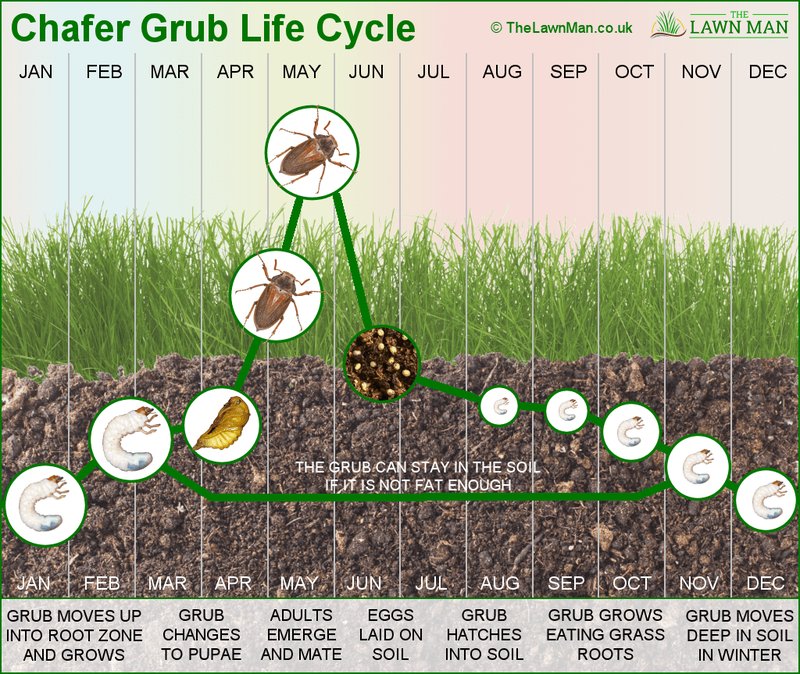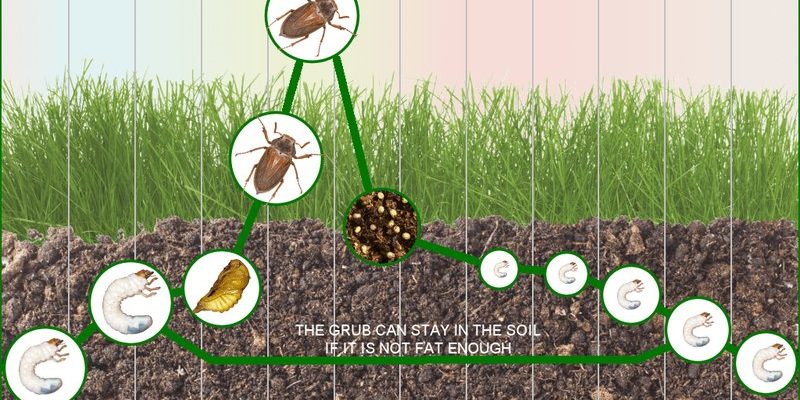
Grub worms are the larval stage of various beetles, primarily belonging to the Scarabaeidae family, like the Japanese beetle. Understanding their lifecycle can help you appreciate their role in nature or even assist in managing them if they become a nuisance in your garden. So, grab your coffee, and let’s dive deeper into the life of these little creatures!
The Stages of the Grub Worm Lifecycle
The lifecycle of a grub worm is typically divided into **four main stages**: egg, larva (grub), pupa, and adult beetle. Throughout this journey, they face different challenges and transformations. Let’s break them down one by one.
1. The Egg Stage
Grub worms usually start their lives as tiny eggs laid by adult beetles. Depending on the species, a female beetle can lay anywhere from **20 to 60 eggs** at a time in the soil, often in late spring or early summer. These eggs are usually round or oval-shaped and about the size of a pinhead.
Once the eggs are laid, they typically take about **two weeks to hatch**. But here’s the catch: the success of this stage heavily depends on environmental factors like moisture and temperature. If conditions are favorable, the eggs hatch into small larvae after this period. If conditions are dry or too cold, it may take longer for them to develop.
2. The Larval Stage (Grubs)
Once the eggs hatch, the **larvae** emerge as what we commonly refer to as grubs. These little guys are usually white, soft-bodied, and have C-shaped bodies. Their primary job during this stage is to eat and grow. They burrow into the soil or munch on roots, organic matter, or decaying plants.
During this stage, grubs can grow quite a bit, sometimes up to **2 inches long**, depending on the species. It’s crucial for them to eat enough to store energy for the next phase. The larval stage can last anywhere from **several weeks to several months**—again, influenced by environmental conditions and food availability.
3. The Pupal Stage
After they’ve grown enough, grubs enter the **pupal stage**. This is where the magic really happens. They dig into the soil and undergo a transformation known as **metamorphosis**. Inside their protective casing, their bodies undergo significant changes to prepare for their next life stage as beetles.
This stage can last anywhere from **a few weeks to several months**, depending on factors like temperature and moisture levels. The pupae are often cream-colored and might be mistaken for grubs, but they are in a stage of transformation. If you dig into your garden during this phase, you might see these pupae nestled in the soil, telling you that change is about to happen.
4. The Adult Beetle
Finally, we arrive at the grand reveal—the **adult beetle** stage. Once they are fully developed and ready, the young beetles emerge from the ground, usually in late spring to early summer. They are typically brown or black and can have a shiny appearance, making them look quite attractive.
Adult beetles have a lifespan that can vary from **a few weeks to several months**. During their life, they engage in mating, lay eggs, and continue the cycle. While they can be beneficial for pollination, some species can also be pests, particularly if they damage your plants or lawn. Recognizing the signs of adult beetles can help you manage them effectively if needed.
Why Understanding the Grub Worm Lifecycle Matters
You might be wondering why all this information about grubs is important. Well, understanding their lifecycle can help in many ways:
– **Gardening and Landscaping**: If you’re a gardener, knowing when grubs are likely to emerge can help you protect your plants and lawn.
– **Pest Control**: Recognizing the stages of their lifecycle can aid in applying the right pest control methods at the right time.
– **Environmental Awareness**: Appreciating the roles grubs and beetles play in the ecosystem fosters a better understanding of nature as a whole.
By being aware of each stage, you can take steps to manage their presence effectively while still respecting their role in the environment.
How to Identify Grubs in Your Garden
Identifying grubs in your garden can be tricky, especially since they spend a lot of time underground. Here are some tips to spot these garden guests:
– **Look for Damage**: If you notice brown patches in your lawn or wilting plants, grubs might be the culprits.
– **Check Soil**: Digging up patches of your lawn can help you find grubs. They’re typically found in the top few inches of soil.
– **Timing**: Late spring or early summer is the prime time for spotting them, as they emerge around this time.
Using these identification techniques can help you determine whether you need to take action to control them or if you can leave them be.
Managing Grub Worms in Your Yard
If you find that grubs are wreaking havoc in your garden, there are various ways to control their population without harmfully affecting the ecosystem:
- Naturally Predatory Species: Encourage birds, beneficial insects, and other predators that feed on grubs.
- Neem Oil: This natural pesticide can disrupt the life cycle of grubs when applied correctly.
- Grub Control Products: If the infestation is severe, purchase specific **grub control products** that target them effectively.
Always consider the impact of your actions on the broader ecosystem. It’s about finding that balance between protecting your garden and allowing nature to do its job.
Grub worms play a fascinating role in our ecosystem, transitioning from tiny eggs to adult beetles in a way that’s both complex and beautiful. By understanding their lifecycle, you can become a better gardener and a more aware steward of the environment. Whether you’re dealing with grubs or simply marveling at the beauty of nature, recognizing their journey enriches your connection to the world around you.
So next time you spot a grub, take a moment to appreciate its journey—because each stage is an essential part of the bigger picture. Happy gardening!

